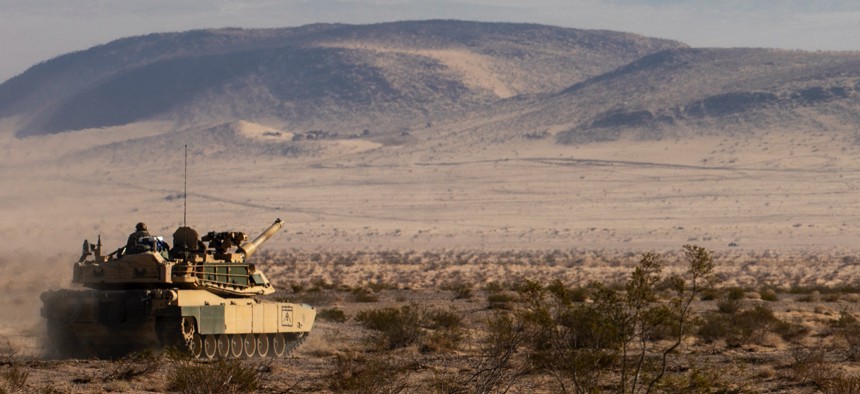
A M1A2 Abrams from the 2nd Armored Brigade Combat Team, 1st Infantry Division travels to its next checkpoint at the National Training Center on Fort Irwin, California, August 6, 2022. U.S. Army / Pfc. Joshua Holladay, 19th Public Affairs Detachment
Divisions, Corps to Replace Brigades As Army’s Wartime Formation Of Choice
Brigades that operated largely independently in Iraq and Afghanistan will fight as part of larger units in future conflicts, officials said.
The Army’s brigade combat teams may have been the signature units of recent wars, but service leaders believe future conflicts will be dominated by divisions and even corps, officials said Monday.
“The large-scale combat [operations] against a peer threat, the amount of complexity, speed, violence, chaos, leads us to the conclusion that our great brigade combat team commanders are going to be wholly consumed winning the fight they're in,” said Gen. James Rainey, the new chief of Army Futures Command, at the Association of the United States Army’s conference in Washington, D.C.
Operations during the Iraq and Afghanistan wars were largely planned by brigade combat teams—some 4,000 troops led by a colonel—and executed by their battalions and companies. Rainey said these BCTs were built in a way that had them hold and operate in an area for a year but were not a “maneuver formation.”
The war in Ukraine has shown what the Army could face in a large-scale conflict, said James Greer, an associate professor at the U.S. Army School for Advanced Military Studies, who spoke on a future-of-warfare panel with Rainey. Ukraine has committed the equivalent of two full corps of troops and is fighting across a vast area, about 150 times larger than the Army’s National Training Center in California, Greer said. A single U.S. Army corps can be comprised of two to five divisions with up to 45,000 soldiers, commanded by a lieutenant general.
“So: very large formations, very large spaces, and of course, everyone's familiar with the lethality, the destruction, the consumption of materiel, ammunition, etc., on a scale that we haven't really thought through in a long time,” Greer said.
Focusing the Army on these larger formations will mean they will be able to work closer with the other services as well as allies and partners, Secretary Christine Wormuth in her Monday keynote.
“Our study and analysis of recent conflicts, exercises, simulation, and training, tells us that brigade commanders must focus fully on winning the close fight. To allow frontline leaders to concentrate on the close fight, division and corps commanders will have the responsibility and capability to visualize the larger picture,” Wormuth said. “To ensure they can do this, our theater armies, corps, and divisions will gain the personnel, organizations, and equipment they need to disrupt and defeat peer adversaries on the future battlefield.”
That means bringing artillery, engineers, and intelligence together at the division level, she said.
Rainey said division commanders will be able to provide these capabilities to the brigades when they need it.
The secretary said this focus on larger formations would be part of the Army’s upcoming doctrine on multi-domain operations, Wormuth said.
“To realize this vision and build the Army of 2030, we are transforming our force structure and evolving how we fight. We must do this to prepare for the challenge of large-scale combat operations, strengthen deterrence in the Indo-Pacific, and to be ready if deterrence fails,” she said.
Rainey pushed back on any would-be critics who say the Army is “going backwards” by going to a division. “And that is absolutely not the case. First of all, everything we're doing is threat-informed.”
The brigades will also have to get smaller in order to survive and move, he said—but did not say how much smaller or what kind of weapons and gear would have to be shed.
The larger formations will also help keep brigades in the fight longer—for weeks and months—and give them “endurance,” which they are seeing as a requirement from what they are learning about the war in Ukraine, Greer said.





